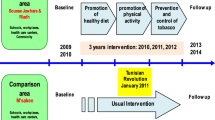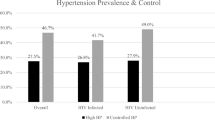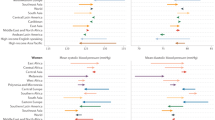Abstract
Trends in blood pressure prevalence and control have important public health implications. We aim to document trends in hypertension prevalence, awareness and control in the older Australian population, a group at greatest risk of blood pressure related diseases. The Blue Mountains Eye Study (BMES) is a population-based study of residents aged 49 years or older, in two postcode areas of the Blue Mountains, Australia. The first cross-section (BMES I, 1992–1994) included 3654 participants (82.4% of eligible). The second cross-section (BMES II, 1997–2000) included 3509 participants, 2335 (75.1% of BMES I survivors) and 1174 (85.2% of newly eligible residents who qualified because of age or moved into the area). Detailed history and examinations were conducted. The prevalence of hypertension increased significantly from 45.4% (95% confidence interval, CI 43.7–47.0%) to 52.2% (CI 50.6–53.9%) from 1992–1994 to 1997–2000, paralleled by an increase in the population mean body mass index (BMI) from 26.1 kg/m2 (CI 26.0–26.3 kg/m2) to 27.7 kg/m2 (CI 27.5–27.9 kg/m2). Hypertension awareness decreased significantly from 79.8 to 73.0%, while treatment and control rates decreased from 71.1 to 67.3% and 56.3 to 46.5%, respectively (P<0.0001). Our results showed that elevated BMI (P<0.0001), lack of exercise (P<0.002) and serum triglyceride >2 mmol/l (P<0.0001) were significantly associated with prevalence of hypertension. We found that the prevalence of hypertension in the older Australian population was increasing while awareness, treatment and control rates decreased. Programmes to improve community awareness of hypertension, and its association with BMI may lead to further reductions in blood pressure and the burden of cardiovascular disease.
This is a preview of subscription content, access via your institution
Access options
Subscribe to this journal
Receive 12 digital issues and online access to articles
$119.00 per year
only $9.92 per issue
Buy this article
- Purchase on Springer Link
- Instant access to full article PDF
Prices may be subject to local taxes which are calculated during checkout


Similar content being viewed by others
References
Chobanian AV et al. The Seventh Report of the Joint National Committee on Prevention, Detection, Evaluation, and Treatment of High Blood Pressure: the JNC 7 report. JAMA 2003; 289: 2560–2572.
National Heart Foundation of Australia. Hypertension Management Guide for Doctors 2004, pp. 1–24. www.heartfoundation.com.au/downloads/hypertension_management_guide_2004.pdf.
Klag MJ et al. End-stage renal disease in African-American and white men. 16-year MRFIT findings. JAMA 1997; 277: 1293–1298.
Kannel WB . Cardioprotection and antihypertensive therapy: the key importance of addressing the associated coronary risk factors (the Framingham experience). Am J Cardiol 1996; 77: 6B–11B.
Lloyd-Jones DM, Evans JC, Larson MG, Levy D . Treatment and control of hypertension in the community: a prospective analysis. Hypertension 2002; 40: 640–646.
Kannel WB . Framingham study insights into hypertensive risk of cardiovascular disease. Hypertens Res 1995; 18: 181–196.
Pringle E et al. Systolic blood pressure variability as a risk factor for stroke and cardiovascular mortality in the elderly hypertensive population. J Hypertens 2003; 21: 2251–2257.
Himmelmann A et al. Isolated systolic hypertension: an important cardiovascular risk factor. Blood Press 1998; 7: 197–207.
Mancia G, Giannattasio C, Grassi G . Current antihypertensive treatment: can we do better? Am J Hypertens 1999; 12: 131S–138S.
Kannel WB, Vasan RS, Levy D . Is the relation of systolic blood pressure to risk of cardiovascular disease continuous and graded, or are there critical values? Hypertension 2003; 42: 453–456.
Walker WG et al. Renal function change in hypertensive members of the Multiple Risk Factor Intervention Trial. Racial and treatment effects. The MRFIT Research Group. JAMA 1992; 268: 3085–3091.
Cherry DK, Woodwell DA . National Ambulatory Medical Care Survey: 2000 summary. Adv Data 2002, 1–32.
Britt H ; et al. General practice activity in Australia 2000–01. 2001, AIHW Cat. No GEP 8.
Hajjar I, Kotchen TA . Trends in prevalence, awareness, treatment, and control of hypertension in the United States, 1988–2000. JAMA 2003; 290: 199–206.
Primatesta P, Brookes M, Poulter NR . Improved hypertension management and control: results from the health survey for England 1998. Hypertension 2001; 38: 827–832.
Wolf-Maier K et al. Hypertension prevalence and blood pressure levels in 6 European countries, Canada, and the United States. JAMA 2003; 289: 2363–2369.
Briganti EM et al. Untreated hypertension among Australian adults: the 1999–2000 Australian Diabetes, Obesity and Lifestyle Study (AusDiab). Med J Aust 2003; 179: 135–139.
Qureshi AI, Suri MF, Guterman LR, Hopkins LN . Ineffective secondary prevention in survivors of cardiovascular events in the US population: report from the Third National Health and Nutrition Examination Survey. Arch Intern Med 2001; 161: 1621–1628.
Lloyd A, Schmieder C, Marchant N . Financial and health costs of uncontrolled blood pressure in the United Kingdom. Pharmacoeconomics 2003; 21(Suppl 1): 33–41.
Chia EM et al. Impact of bilateral visual impairment on health-related quality of life: the Blue Mountains Eye Study. Invest Ophthalmol Vis Sci 2004; 45: 71–76.
Mitchell P, Smith W, Attebo K, Wang JJ . Prevalence of age-related maculopathy in Australia. The Blue Mountains Eye Study. Ophthalmology 1995; 102: 1450–1460.
World Health Organization, International Society of Hypertension Writing Group. World Health Organization (WHO)/International Society of Hypertension (ISH) statement on management of hypertension. J Hypertens 2003; 21: 1983–1992.
Chaudhry SI, Krumholz HM, Foody JM . Systolic hypertension in older persons. JAMA 2004; 292: 1074–1080.
Australian Bureau of Statistics. Census: Basic Community Profile. Australian Bureau of Statistics: Canberra, (2001).
Breslow NE, Day NE . In: Statistical Methods in Cancer Research, Vol II. International Agency for Research on Cancer: Lyon, 1987, pp 48–79.
Uemura K, Pisa Z . Trends in cardiovascular disease mortality in industrialized countries since 1950. World Health Stat Q 1988; 41: 155–178.
Murray CJ, Lopez AD . Mortality by cause for eight regions of the world: Global Burden of Disease Study. Lancet 1997; 349: 1269–1276.
Anderson TW . Re-examination of some of the Framingham blood-pressure data. Lancet 1978; 2: 1139–1141.
Rodgers A et al. Blood pressure and risk of stroke in patients with cerebrovascular disease. The United Kingdom Transient Ischaemic Attack Collaborative Group. BMJ 1996; 313: 147.
Burt VL et al. Trends in the prevalence, awareness, treatment, and control of hypertension in the adult US population. Data from the health examination surveys, 1960 to 1991. Hypertension 1995; 26: 60–69.
Fields LE et al. The burden of adult hypertension in the United States 1999 to 2000: a rising tide. Hypertension 2004; 44: 398–404.
Truelsen T et al. Trends in stroke and coronary heart disease in the WHO MONICA Project. Stroke 2003; 34: 1346–1352.
Marques-Vidal P, Ruidavets JB, Cambou JP, Ferrieres J . Trends in hypertension prevalence and management in Southwestern France, 1985–1996. J Clin Epidemiol 2000; 53: 1230–1235.
Arnett DK et al. Fifteen-year trends in cardiovascular risk factors (1980–1982 through 1995–1997): the Minnesota Heart Survey. Am J Epidemiol 2002; 156: 929–935.
Evans A et al. Trends in coronary risk factors in the WHO MONICA project. Int J Epidemiol 2001; 30(Suppl 1): S35–S40.
Colhoun HM, Dong W, Poulter NR . Blood pressure screening, management and control in England: results from the health survey for England 1994. J Hypertens 1998; 16: 747–752.
Psaty BM et al. Time trends in high blood pressure control and the use of antihypertensive medications in older adults: the Cardiovascular Health Study. Arch Intern Med 2002; 162: 2325–2332.
Wilson PW et al. Overweight and obesity as determinants of cardiovascular risk: the Framingham experience. Arch Intern Med 2002; 162: 1867–1872.
Folsom AR et al. Associations of general and abdominal obesity with multiple health outcomes in older women: the Iowa Women's Health Study. Arch Intern Med 2000; 160: 2117–2128.
Brown CD et al. Body mass index and the prevalence of hypertension and dyslipidemia. Obes Res 2000; 8: 605–619.
Steinberg HO et al. Obesity/insulin resistance is associated with endothelial dysfunction. Implications for the syndrome of insulin resistance. J Clin Invest 1996; 97: 2601–2610.
Vigili DK, Kiwanuka E, Tiengo A, Avogaro A . Visceral obesity is characterized by impaired nitric oxide-independent vasodilation. Eur Heart J 2003; 24: 1210–1215.
Pescatello LS et al. American College of Sports Medicine position stand. Exercise and hypertension. Med Sci Sports Exerc 2004; 36: 533–553.
Hansson L et al. Effects of intensive blood-pressure lowering and low-dose aspirin in patients with hypertension: principal results of the Hypertension Optimal Treatment (HOT) randomised trial. HOT Study Group. Lancet 1998; 351: 1755–1762.
Davis BR et al. Rationale and design for the Antihypertensive and Lipid Lowering Treatment to Prevent Heart Attack Trial (ALLHAT). ALLHAT Research Group. Am J Hypertens 1996; 9: 342–360.
Black HR et al. Baseline characteristics and Early Blood Pressure Control in the CONVINCE Trial. Hypertension 2001; 37: 12–18.
Wiklund I, Halling K, Ryden-Bergsten T, Fletcher A . Does lowering the blood pressure improve the mood? Quality-of-life results from the Hypertension Optimal Treatment (HOT) study. Blood Press 1997; 6: 357–364.
Grimm Jr RH et al. Relationships of quality-of-life measures to long-term lifestyle and drug treatment in the Treatment of Mild Hypertension Study. Arch Intern Med 1997; 157: 638–648.
Author information
Authors and Affiliations
Corresponding author
Rights and permissions
About this article
Cite this article
Chua, B., Rochtchina, E. & Mitchell, P. Temporal changes in the control of blood pressure in an older Australian population. J Hum Hypertens 19, 691–696 (2005). https://doi.org/10.1038/sj.jhh.1001881
Received:
Revised:
Accepted:
Published:
Issue Date:
DOI: https://doi.org/10.1038/sj.jhh.1001881
Keywords
This article is cited by
-
Untreated hypertension: prevalence and patient factors and beliefs associated with under-treatment in a population sample
Journal of Human Hypertension (2013)



